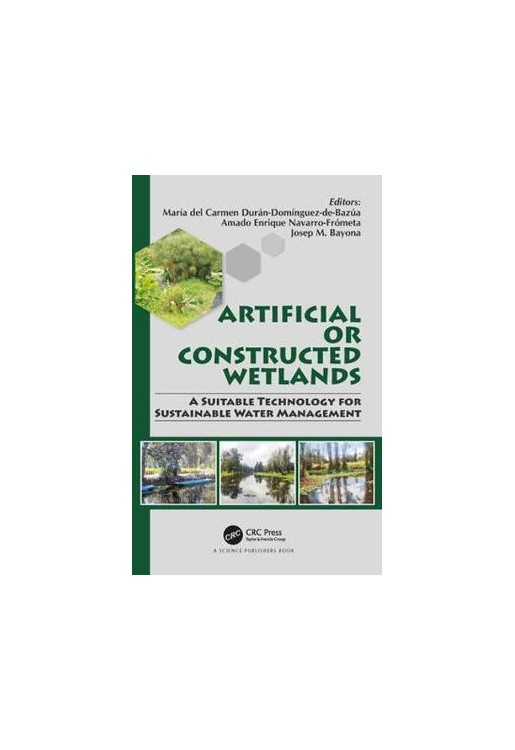As plants and microorganisms are a fundamental part of the correct functioning of these systems, their contribution to the degradation of the organic matter and to the removal and transformation of the pollutant compounds present in the wastewaters, including those of emerging concern, is a highlight of this book.
Introduction
Xochimilco, Mexico, a Natural Wetland or an Artificial One?
Victor Jesus Garcia-Luna, Marisela Bernal-Gonzalez, Federico Alfredo Garcia-Jimenez and Maria del Carmen Duran-Dominguez-de-Bazua
Rhizospheric Processes for Water Treatment - Background Principles, Existing Technology and Future Use
Uwe Kappelmeyer and Lara A. Aylward
Use of Artificial Wetlands as Degradation Systems of Recalcitrant Contaminants and Transformers of Energy to Electricity
Aranys del Carmen Borja-Urzola, Citlaly Marisol Hernandez-Arriaga, Oscar Hugo Miranda-Mendez, Maria Guadalupe Salinas-Juarez, Marisela Bernal-Gonzalez and Maria del Carmen Duran-Dominguez-de-Bazua
Constructed Wetlands for the Tertiary Treatment of Municipal Wastewaters: Case Studies in Mexico at Mesocosm Level
Jorge Antonio Herrera-Cardenas and Amado Enrique Navarro-Frometa
Effect of Support Media on Heavy Metals Removal in Constructed Wetlands Inoculated with Metallotolerant Strains
Leonel Ernesto Amabilis-Sosa, Arroyo-Ginez-Marcela, Ruth Perez-Gonzalez, Adriana Roe-Sosa, Landy Irene Ramirez-Burgos and Maria del Carmen Duran-Dominguez-de-Bazua
Full-Scale Applications of Constructed Wetlands in Africa
Diederik P.L. Rousseau
Application of a Multi-function Constructed Wetland for Stream Water Quality Improvement and Ecosystem Protection: A Case Study in Kaohsiung City, Taiwan
C.M. Kao, W.H. Lin, P.J. Lien, Y.T. Sheu and Y.T. Tu
Constructed Wetlands Technology in Cuba: Research Experiences
Irina Salgado-Bernal, Maira M. Perez-Villar, Lizandra Perez-Bou, Mario Cruz-Arias, Margie Zorrilla-Velazco and Maria E. Carballo-Valdes
Greenhouse Gas Emissions and Treatment Performance in Constructed Wetlands with Ornamental Plants: Case Studies in Veracruz, Mexico
Maria Elizabeth Hernandez-Alarcon and Jose Luis Marin-Muniz
Treatment of Wastewater from Livestock Activities with Artificial or Constructed Wetland
Jose Marrugo-Negrete, Juan Figueroa-Sanchez, Ivan Urango-Cardenas and German Enamorado-Montes
REAGRITECH Project: Regeneration and Reuse of Runoff and Drainage Water from Agriculture by Treatment Wetlands
Lorena Aguilar, Angel Gallegos, Carlos A. Arias and Jordi Morato
Bioremediation of Shrimp Aquaculture Effluents: Artificial Wetlands Potential Use
Otoniel Carranza-Diaz and Jose Guillermo Galindo-Reyes
Fate of Contaminants of Emerging Concern in Constructed Wetlands
Victor Matamoros and Maria Hijosa-Valsero
Electrochemically Assisted Artificial Wetlands: Generating Electricity from
Wastewater Treatment
Maria Guadalupe Salinas-Juarez
Predictive Models to Assess the Uptake of Organic Microcontaminants and Antibiotic Resistant Bacteria and Genes by Crops
Josep M. Bayona, Stefan Trapp, Benjamin Pina and Fabio Polesel
The Role of Macrophytes in the Removal of Organic Micropollutants by Constructed Wetlands
A. Dordio, A.J.P. Carvalho, M. Hijosa-Valsero and E. Becares
Influence of Design and Operation Parameters in the Organic Load and Nutrient Removal in Constructed Wetlands
Jason A. Hale and Joan Garcia Serrano
Design and Construction of an Artificial Subsuperficial Wetland of Double Cell. An Experience in Palmillas, Queretaro Mexico
Salvador Alejandro Sanchez-Tovar
Strategies of the Constructed Wetlands Operation under the Perspective of the Global Change Scenario
Gladys Vidal, Daniela Lopez, Ana Maria Leiva, Gloria Gomez, William Arismendi and Sujey Hormazabal
Uptake and Detoxification of Organic Micropollutants by Macrophytes in Constructed Wetlands
A. Dordio, A.J.P. Carvalho, M. Hijosa-Valsero and E. Becares
Glossary


